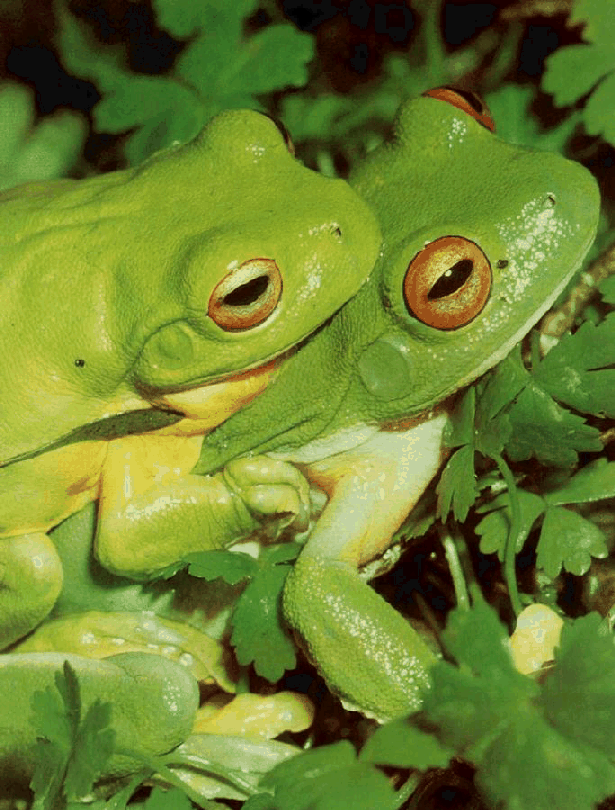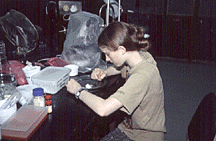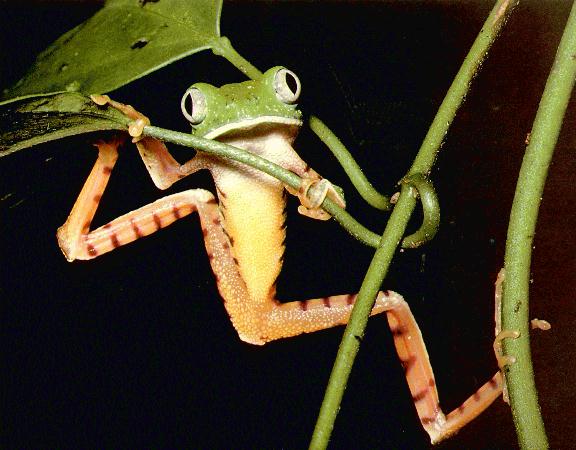Froth, Foam and Bubble....
The Foam Nests of Trinidadian Frogs
 Several species of tropical frog
lay their eggs in stable foams which persist until the tadpoles emerge. The function
of the foams remains uncertain but several possibilities exist, such as isolating
the developing eggs from predation, protecting them from infection, dehydration,
or sun damage. Whatever the function of the foams may be, they merit investigation
for two main reasons. First, despite being within easy reach for a range of organisms
which could colonise and destroy the foam and the eggs (bacteria, fungi, nematodes,
etc.), they are observed to remain intact for the several days required for the
completion of development. They may, therefore, contain novel anti-microbial compounds
which could teach us something new about the mechanisms of action of natural anti-microbial
agents. Secondly, little is known about the composition of the foams and the molecular
mechanisms by which the foams are formed and remain stable for such lengths of
time. Moreover, should the nest foams contain surfactants, then these are of intrinsic
interest because they must be compatible with a very sensitive developing tissue,
and a vertebrate one at that. A simple detergent, for example, would be membrane-disruptive,
and the foam may not be stable anyway. Aside from satisfying curiosity, the work
might lead to clinically or industrially useful applications.
Several species of tropical frog
lay their eggs in stable foams which persist until the tadpoles emerge. The function
of the foams remains uncertain but several possibilities exist, such as isolating
the developing eggs from predation, protecting them from infection, dehydration,
or sun damage. Whatever the function of the foams may be, they merit investigation
for two main reasons. First, despite being within easy reach for a range of organisms
which could colonise and destroy the foam and the eggs (bacteria, fungi, nematodes,
etc.), they are observed to remain intact for the several days required for the
completion of development. They may, therefore, contain novel anti-microbial compounds
which could teach us something new about the mechanisms of action of natural anti-microbial
agents. Secondly, little is known about the composition of the foams and the molecular
mechanisms by which the foams are formed and remain stable for such lengths of
time. Moreover, should the nest foams contain surfactants, then these are of intrinsic
interest because they must be compatible with a very sensitive developing tissue,
and a vertebrate one at that. A simple detergent, for example, would be membrane-disruptive,
and the foam may not be stable anyway. Aside from satisfying curiosity, the work
might lead to clinically or industrially useful applications.
 The object of this project was to
collect foam produced by two species of frog, Physalaemus pustulosus,
which lays its foam nest on or near the surface of small pools of standing water,
and Leptodactylus fuscus, which lays its foam nest in mud burrows immediately
adjacent to pools. Foam was collected, under Roger Downie's specialised guidance,
the eggs removed, and the foam frozen for return to Glasgow for analysis. The
separation was carried out either by hand (laboriously carried out by Isla and
Ross Kennedy - with help from Freya Kennedy, who also played a major role as
morale booster) or by gentle centrifugation. Centrifugation also compresses
the foam and provides a liquid which is easier to analyse than a foam.
The object of this project was to
collect foam produced by two species of frog, Physalaemus pustulosus,
which lays its foam nest on or near the surface of small pools of standing water,
and Leptodactylus fuscus, which lays its foam nest in mud burrows immediately
adjacent to pools. Foam was collected, under Roger Downie's specialised guidance,
the eggs removed, and the foam frozen for return to Glasgow for analysis. The
separation was carried out either by hand (laboriously carried out by Isla and
Ross Kennedy - with help from Freya Kennedy, who also played a major role as
morale booster) or by gentle centrifugation. Centrifugation also compresses
the foam and provides a liquid which is easier to analyse than a foam.
A comprehensive analysis of this unusual biological material
requires a team effort.....
 Roger Parton (Infection
and Immunity) helps in the search for anti-microbial compounds, Les Fixter,
John Kusel and John Beeley (Biochemistry and Molecular Biology) look for lipids,
carbohydrates and surface-active compounds in the foams, and Alan Cooper (Chemistry),
Malcolm Kennedy (I&I) - assisted by Tennie Videler and Emma Wilson - along with
Nick Price in Stirling University, examine the biophysical properties of proteins
purified from the foams. The work is supported by a grant from the Wellcome
Trust under a new scheme (Sir Henry Wellcome Commemorative "Showcase" Awards)
to support unusual research directions.
Roger Parton (Infection
and Immunity) helps in the search for anti-microbial compounds, Les Fixter,
John Kusel and John Beeley (Biochemistry and Molecular Biology) look for lipids,
carbohydrates and surface-active compounds in the foams, and Alan Cooper (Chemistry),
Malcolm Kennedy (I&I) - assisted by Tennie Videler and Emma Wilson - along with
Nick Price in Stirling University, examine the biophysical properties of proteins
purified from the foams. The work is supported by a grant from the Wellcome
Trust under a new scheme (Sir Henry Wellcome Commemorative "Showcase" Awards)
to support unusual research directions.
Our colleagues may think we are crazy even thinking about this
project, but not as crazy as Trinidadians thought we were collecting frog
nests from dirty ditches and ponds in a graveyard! Perhaps they will all be
proved correct.
Malcolm Kennedy
Alan Cooper
Click for some pictures of the Trinidad 1997/8 foam
collection expeditions.
Click for a video clip of the foam nesting process.
Return to Biophysical Chemistry home page.
 The object of this project was to
collect foam produced by two species of frog, Physalaemus pustulosus,
which lays its foam nest on or near the surface of small pools of standing water,
and Leptodactylus fuscus, which lays its foam nest in mud burrows immediately
adjacent to pools. Foam was collected, under Roger Downie's specialised guidance,
the eggs removed, and the foam frozen for return to Glasgow for analysis. The
separation was carried out either by hand (laboriously carried out by Isla and
Ross Kennedy - with help from Freya Kennedy, who also played a major role as
morale booster) or by gentle centrifugation. Centrifugation also compresses
the foam and provides a liquid which is easier to analyse than a foam.
The object of this project was to
collect foam produced by two species of frog, Physalaemus pustulosus,
which lays its foam nest on or near the surface of small pools of standing water,
and Leptodactylus fuscus, which lays its foam nest in mud burrows immediately
adjacent to pools. Foam was collected, under Roger Downie's specialised guidance,
the eggs removed, and the foam frozen for return to Glasgow for analysis. The
separation was carried out either by hand (laboriously carried out by Isla and
Ross Kennedy - with help from Freya Kennedy, who also played a major role as
morale booster) or by gentle centrifugation. Centrifugation also compresses
the foam and provides a liquid which is easier to analyse than a foam.
 Several species of tropical frog
lay their eggs in stable foams which persist until the tadpoles emerge. The function
of the foams remains uncertain but several possibilities exist, such as isolating
the developing eggs from predation, protecting them from infection, dehydration,
or sun damage. Whatever the function of the foams may be, they merit investigation
for two main reasons. First, despite being within easy reach for a range of organisms
which could colonise and destroy the foam and the eggs (bacteria, fungi, nematodes,
etc.), they are observed to remain intact for the several days required for the
completion of development. They may, therefore, contain novel anti-microbial compounds
which could teach us something new about the mechanisms of action of natural anti-microbial
agents. Secondly, little is known about the composition of the foams and the molecular
mechanisms by which the foams are formed and remain stable for such lengths of
time. Moreover, should the nest foams contain surfactants, then these are of intrinsic
interest because they must be compatible with a very sensitive developing tissue,
and a vertebrate one at that. A simple detergent, for example, would be membrane-disruptive,
and the foam may not be stable anyway. Aside from satisfying curiosity, the work
might lead to clinically or industrially useful applications.
Several species of tropical frog
lay their eggs in stable foams which persist until the tadpoles emerge. The function
of the foams remains uncertain but several possibilities exist, such as isolating
the developing eggs from predation, protecting them from infection, dehydration,
or sun damage. Whatever the function of the foams may be, they merit investigation
for two main reasons. First, despite being within easy reach for a range of organisms
which could colonise and destroy the foam and the eggs (bacteria, fungi, nematodes,
etc.), they are observed to remain intact for the several days required for the
completion of development. They may, therefore, contain novel anti-microbial compounds
which could teach us something new about the mechanisms of action of natural anti-microbial
agents. Secondly, little is known about the composition of the foams and the molecular
mechanisms by which the foams are formed and remain stable for such lengths of
time. Moreover, should the nest foams contain surfactants, then these are of intrinsic
interest because they must be compatible with a very sensitive developing tissue,
and a vertebrate one at that. A simple detergent, for example, would be membrane-disruptive,
and the foam may not be stable anyway. Aside from satisfying curiosity, the work
might lead to clinically or industrially useful applications.
 Roger Parton (Infection
and Immunity) helps in the search for anti-microbial compounds, Les Fixter,
John Kusel and John Beeley (Biochemistry and Molecular Biology) look for lipids,
carbohydrates and surface-active compounds in the foams, and Alan Cooper (Chemistry),
Malcolm Kennedy (I&I) - assisted by Tennie Videler and Emma Wilson - along with
Nick Price in Stirling University, examine the biophysical properties of proteins
purified from the foams. The work is supported by a grant from the
Roger Parton (Infection
and Immunity) helps in the search for anti-microbial compounds, Les Fixter,
John Kusel and John Beeley (Biochemistry and Molecular Biology) look for lipids,
carbohydrates and surface-active compounds in the foams, and Alan Cooper (Chemistry),
Malcolm Kennedy (I&I) - assisted by Tennie Videler and Emma Wilson - along with
Nick Price in Stirling University, examine the biophysical properties of proteins
purified from the foams. The work is supported by a grant from the